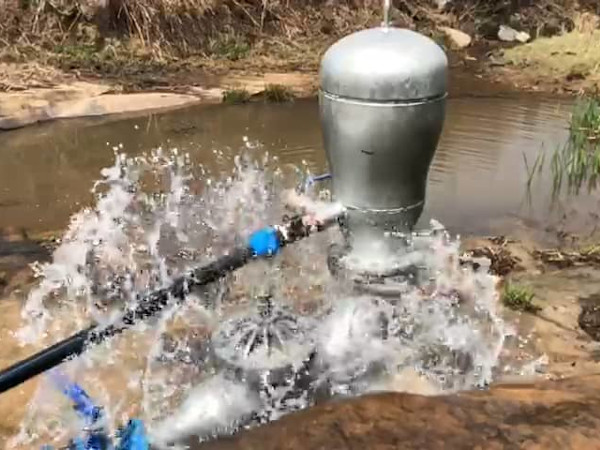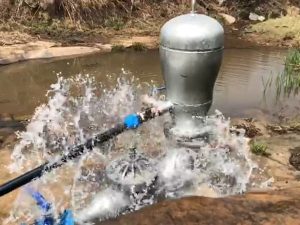“Hydraulic ram pumps can lift water over a considerable elevation, and do not require any external power source.” – W. Bryan Smith, Clemson University
Contents
What are hydraulic ram pumps?
Called ‘hydrams’ for short, hydraulic ram pumps are self-powered water pumps that can be used to pump water to higher ground for irrigation, watering livestock or human use. The power for pumping comes from the flow of water via gravity to the pump, and doesn’t require a generator, electricity or even wind. Hyrdrams can lift water to ten times the height of the fall to it from the source of water. They operate continuously, 24 hours per day, 7 days per week.
How do they work?
Hydrams turn the potential energy in a head of water into kinetic energy, then re-convert it to potential energy again, in the form of pressure that pushes the water uphill. This is a diagram of a typical set-up.

Image: Blake’s Hydram
A feed well contains water from a watercourse, from which there needs to be a fall. Water flows down to the pump via a ‘drive pipe’ to the hydram. Very basically, when the falling water reaches a high-enough speed, its drag causes a valve in the pump to snap shut quickly, causing a pressure spike / shock wave that compresses a cushion of air in the air vessel at the top of the pump, which provides a steady pressure release to push the water uphill. Then the pressure falls, the valve opens and water starts to flow through again. When it reaches the right speed, the valve snaps shut and the pump kicks in again, in a continuous cycle.
History
Hydraulic ram pumps date back to the 18th century, with precursors developed in Britain, before one of the Montgolfier brothers (of hot air balloon fame) invented the first true hydram in 1796. The original design hasn’t really changed very much at all. At around 60-80% efficiency, there’s not too much scope for improvement.
They’ve declined in popularity recently because many people would prefer to install cheap, disposable pumps and pay for electricity, rather than invest in a resilient, long-term, sustainable alternative. As with many aspects of society, the focus tends to be on ease and disposability rather than building a long-term asset. We’d like to see a reverse in that way of thinking (before nature steps in to force our hand).

What are the benefits of hydraulic ram pumps?
A hydram is an environmentally-sound solution for water pumping. The main benefit is that they don’t require a power source, therefore avoiding the pollution and carbon emissions associated with power generation.
They’re obviously even more beneficial if you don’t have mains electricity on site.
There’s a reasonably large capital investment required to install them, but long-term, they provide better value than electric or petrol / diesel pumps in that running costs are minimal; they don’t require electricity or fuel to run them, they require less maintenance and they last much, much longer.
Spare parts are available for very old equipment – it’s a technology that hasn’t changed much over the decades.
It’s cheaper and easier than digging a borehole and using an electric pump to deliver the water from it.

What can I do?
First make sure your site conditions suit a hydram. There has to be a fall from the originial water source, and a way to get the excess water back into the water course. So a steep hill stream is good, and on lower ground, maybe a waterfall or a bend in a river, with a fall to either the same water course or a different one. In some cases, the hydram can be located in a pit to allow an adequate fall, although excess water must be allowed to drain back to the source at a lower level somehow. The minimum fall from the top of the feed well down to the waste pipe from the pump is 1.1 metres. Water can be delivered to much greater heights than the fall to the pump.
Only a small amount of water that arrives at the hydram is pumped (90% is not pumped, and overflows back to the watercourse), but it can chug away 24-7, which means that even a small pump can deliver a few cubic metres of water per day, which will be enough for smallholders with a few animals or a small area of plants to irrigate. It can be used for household supply too if the source is clean – for example a mountain stream. You can use a UV filter if you’re going to drink it (although people have been drinking from highland water sources since way before UV filters existed).
Let your local water authority know that you intend to divert some water.
There are sometimes grants for installing ram pumps, so it might be a good idea to contact your local authority to check.

Installation
See the diagram above. You’ll need concrete pads for the feed well (which could be a concrete-lined pit or a large plastic barrel) and to bolt the pump to. The feed well can be at a distance from the source, and needs a roof to keep out debris (the pump itself doesn’t necessarily need a cover).
The drive pipe needs to be rigid, and to have a steady fall, and needs to be around 4-5 times the length of the overall fall. Galvanised steel is the best material, because plastic expands slightly and allows some of the shock wave to dissipate rather than using all the force to drive the water uphill.

The delivery pipe can be of any material. It’s best to pump the water to a holding tank, from where it can be delivered to where it’s required by gravity. The delivery pipe should be fitted with a non-return valve as it leaves the pump, so that it stays full of water if it gets disconnected from the pump for any reason.
Manufactured hydrams can pump water to a height of 120 metres over a distance of up to 2 miles.
See here for more details on installation, including sizes.
Build your own
You can build your own hydram, although you’re not going to get near the efficiency of a manufactured pump, and won’t last anywhere near as long. But they’re cheap and easy to build, and you can check that a hydram works well in your location before investing in a manufactured pump.
Metal is obviously more robust and will last longer than plastic.
See here for more details on building your own hydram, including flow rates, troubleshooting etc.

Maintenance
You’ll need to change some fittings, such as the rubber valves, maybe every couple of years. One or two other fittings may need to be replaced every 10 years or so. It’s not arduous. Easy to take apart – no specialist skills needed.
Make sure there’s not too much mud, silt or sand coming down the drive pipe, as it will wear out the pump parts more quickly. Check after the installation, to see if you need to add any pre-filters to the feed pipe.
If you’re watering animals, you’ll need to check the troughs every day to make sure that the pump is still working.
Specialist(s)
Thanks to David Green of Blake’s Hydram for information.
The specialist(s) below will respond to queries on this topic. Please comment in the box at the bottom of the page.

David Green has 45 years of service at Allspeeds and is an expert on John Blake ram pumps, Allspeeds Variators and Tangye hydraulic jacks, over his extensive career he has first-hand knowledge of materials, manufacturing, sales and service, if David can’t help you with your enquiry, no-one can!



10 Comments
We bought a ram pump and it is not working. Do you know of ANYONE in the central Oregon region that can talk to us about troubleshooting? HELP please!
What fabulous appropriate technology that I knew nothing about. Many thanks for the info David!
I’ve been using a high lifter pump to pump water about 500 feet of lift from where the pump sits. It too uses falling water to pump water based on pascals hydraulic principle. The inventor and sole proprietor of this business that sells high lifters seems to be out of commission, possibly a Covid vaccine injury victim. I’m thinking about using a ram pump instead. Can I pump water up that high with a ram? I get 60 psi @ about 6-8 gallons per minute at my pump site.
I need to take what up a mountain say roughly over 350 feet high what do recommend?
In Answer to Richard Bayne the Hydram uses the potential energy in the falling water to pump a proportion of that water up to 120 meters in vertical height.
One Bar (14.5psi) of pressure will lift water to 10 meters, the quantity of water lifted depends on volume available.
With 60psi available a Hydram would only be able to lift water to 40 meters (131 feet) so would not be suitable for your application.
David
In Answer to Darwin.
in order to ascertain which hydram would be suitable for your needs you require the following information
The working fall. (difference height from water source to hydram).
Volume of water available.
Height to which you wish to raise the water.
I suggest you visit the John Blake website listed above for more details on how to do this.
David
Is this to municipal water distribution in replacement to booster pumps?
John ABDL – they’re mainly for delivering water to livestock.
Hello David,
We don’t have much of a fall but we have high volume flow at 4 knots or so. Need to achieve about 120 foot lift. I was planning to use a large turbine to drive a small pump but a hydram may be a better/cheaper solution if we can achieve sufficient pressure. What do you think?
Thanks,
Gene
in reply to Gene
Hi Gene,
The minimum working fall for a hydram is about 1 meter (3 foot) anything less than this then a hydram is not the correct solution.
with a 1 meter fall you can get the lift you require but may not get the volume of water you require.
It is best to check with the manufacturer of the ram pump to see what is possible. You will need to give them the working fall available, the volume of water available in liters per minute and the height to which you wish to lift the water. They will then be able to tell you how much water can be delivered in 24 hours.
Regards
David